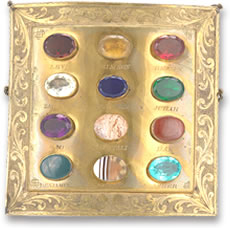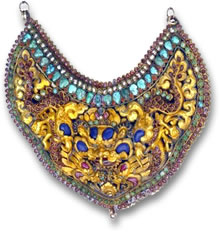|
|
Your Details
|
|
Your Details
|
Reviewed By Andreas Zabczyk
Breastplates and Bib Necklaces Breastplate of the Torah with Colored Gems
Breastplates have been around for centuries. They have been worn for protection against injury to the torso by soldiers, and also for spiritual protection, by ancient Egyptians. Modern day birthstones - gems that are assigned to each month of the year - originate from the Breastplate of the Israelites' High Priest, Aaron, described in the Book of Exodus of the Bible. This was a sacred item that is also referred to as the "Breastplate of Judgement" because it was believed to have been used for divination purposes. Another type of religious breastplate is the Torah Breastplate (also known as Hoshen), which is not worn around the neck, but used to decorate Judaic scrolls (called Sefer Torah). This is usually made from silver and is thought to be connected with the Breastplate of Aaron. The Torah Breastplate design can vary according to region. Ancient Egyptian mummies have been found wrapped with protective pectoral ornaments and collar necklaces. For example, the mummy of King Tutankhamun had several such amulets, including falcon and scarab beetle pectorals decorated with lapis lazuli, turquoise, carnelian and other materials. Ancient Egyptian pectorals could be suspended from the neck or worn as brooches. They were generally placed on mummies over the body parts that they were intended to protect. Nowadays, African tribes such as the Maasai still fashion traditional and elaborate breastplate necklaces out of colorful beads and other materials. Gold Mesoamerican BreastplateAncient European ornamental breastplates tended to be made of gold and other metals, such as those of the Thracians of South-Eastern Europe and the Etruscans of ancient Italy. These were sometimes decorated with rosettes and images of animals, such as lions. Ancient Mesoamerican breastplates and pectorals were also made from hammered gold and decorated with human-like or supernatural images. Many Native American Indians from the Great Plains and Eastern Woodlands wore breastplates which were fashioned from long, slim beads known as hair pipes. These were worn by both men and women and made from conch shell, bone, rolled copper, silver, stone or glass. Hair pipe breastplates were often large, rectangular or chevron-shaped adornments, which sometimes featured tassels. The long beads were often strung onto buckskin cords. The hair pipe beads were sometimes several inches long and some breastplates contained over one hundred beads. Hair pipes were also used in choker necklaces and earrings.  Himalayan Gemstone Breastplate
Other people from cultures all over the world have made breastplates, such as the Hmong people from the mountainous areas south of China. Hmong breastplates are fashioned from beautifully etched silver pieces. The people of Ladakh in Northern India have amazingly intricate breastplate ornaments fashioned from turquoise, carnelian, coral and other gemstones. Some particularly striking Nepalese breastplates have been made from gilded copper and set with ruby, turquoise and coral cabochons. Such traditional breastplate designs have inspired modern breastplate necklaces. Breastplate necklaces or bib necklaces have a broad front section that covers part of the chest. These necklaces can also be tribal style, high style or modern street style. They may be big and bold with large heavy pieces, or light and dainty, with just a few chains or beads. While the terms "breastplate" and "bib" are sometimes used interchangeably, bib necklaces generally have a rounded shape and breastplates tend to have flat or elongated parts that sit against the chest. If you are thinking of making or wearing a necklace, consider a breastplate or bib necklace. It can be a statement piece full of colored gems or a light chain with a small splash of color that makes a change from the usual. It may not protect you from harm or contain special powers, but it will look amazing. |
